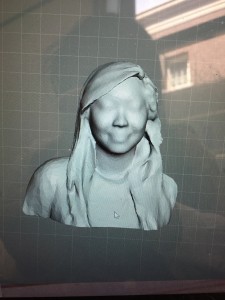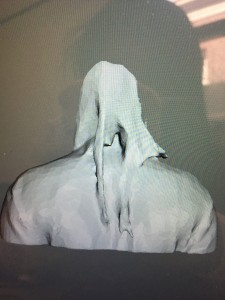This week for class we worked on 3D scanning and printing using two types of scanning technologies. One was on the ipad and used the camera and a piece of add on hardware and software to scan. The other was through propriety scanning hardware and software called geomagic.
The way the 3D scanning software works is it uses laser triangulation. Geomagic uses short-midrange laser triangulation and how it does that is the laser configuration scans across object, the sensor then picks up on reflections from all different angles, and it uses trig to finish up filling in any empty spaces.
I tried both the technologies and found that my hair (and the back of the chair) was where the real issues were when it came to using Geomagic. The ipad was able to scan the human head much better if you had a long sheet of flat hair. Both my partner and I could not get scanned using Geomagic but the IPad worked. When Harina put her hair in a braid, Geomagic worked. It is a much trickier technology to handle than I previously thought. The scans turn out pretty accurate though. I am interested in seeing how accurate scanning of a person versus an object is. I noticed there were two features through Geomagic so I would love to explore how scanning these two subjects affect the accuracy of the final STL file.


What we used to process the scans was Autodesk meshmixer—this is the software that is able to process the STL file that Geomagic saves it as. It was a surprisingly accurate scan. The only thing I wished I could see more nuances with were my eyes. I would say the capture was fairly accurate to how I looked that day. It was able to capture ruffles in my hair and specific details in my clothing so I was pretty impressed with the Ipad scan. Looking at my partner’s scan, I noticed it captured the details of her braid which was pretty impressive. It lost her glasses though. I would love to see how scanning technology improves as software gets more and more accurate.
Ariel also came in to talk about some more practical applications of 3D scanning besides just printing a scan of our bust. She used the scanning technology to get an accurate scan of the grip she uses for Paralympic wheelchair events. I could see scanning being very useful in the medical industry for customization of products. It would be a much faster fix if every hospital had a 3D printer to make custom casts or crutches.

